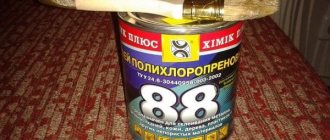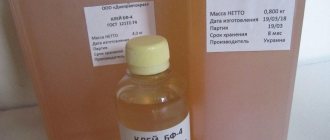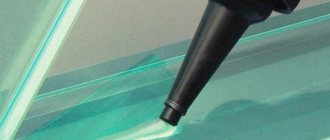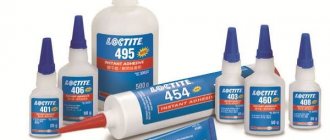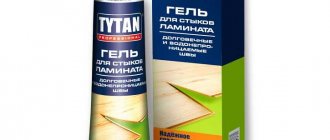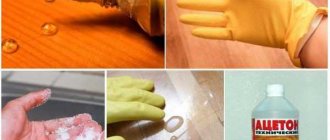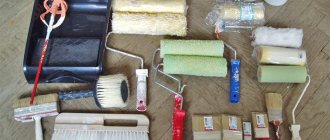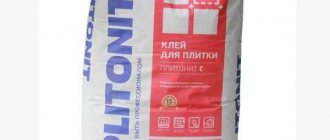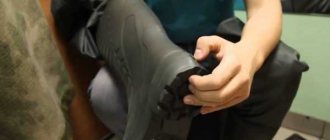Titanium glue is a universal glue, which is explained by its high technological properties. Titanium can be used for gluing products made of foam plastic, wood, PVC, leatherette and others. It has proven itself well for installing finishing elements on surfaces made of concrete, wood, plaster, including ceiling tiles. The adhesive can be used for external and internal work; the connection is characterized by elasticity, moisture resistance and frost resistance. Eco-friendly because does not contain solvents hazardous to health. If Titanium has thickened, you can use alcohol, including salicylic acid or denatured alcohol, to dilute it. In its liquid state, Titanium does not bond well, but can be used as a primer. Craftsmen, when advising how to dilute Titan glue, can point to nail remover. It should be borne in mind that the use of isopropanol-based nail remover may cause the glue to curdle (photo).
How to remove Dragon glue stain?
The instructions advise diluting it with denatured alcohol or the “Denatured” composition from. When attaching ceramic tiles, do not treat them with water. Dragon glue is applied in stripes or dotted lines. If you are treating a large surface area, you can use a notched trowel.
Interesting materials:
How to clean a Xiaomi phone before selling it? How to clean dark tiles? How to clean the heating element of a washing machine from scale with citric acid? How to clean a stainless steel grater? How to clean grease from a grater? How to clean sofa fabric? How to clean fabric on chairs? How to clean fabric from glue? How to remove paint from fabric? How to clean oil from fabric?
Method of using Titanium adhesive for ceiling tiles
Regardless of the choice of adhesive composition and method of application, before applying adhesive for foam ceiling tiles, it is necessary to carefully prepare the ceiling surface. All existing cracks and crevices must be repaired and completely sealed.
Tiles can only mask minor irregularities, so if there are significant differences in the ceiling, then its surface must be leveled, then a layer of finishing putty must be applied, and then primed. In addition, it is not recommended to glue ceiling tiles to whitewash.
The method of using Titan glue depends on the form of release and is indicated by the manufacturer on the packaging. There are three main types of adhesive:
- Universal glue.
Used for gluing ceiling tiles, parquet, linoleum and wood. It is a colorless composition that is squeezed out in a thin strip from a sealed package. To glue ceiling tiles, glue is applied to its inner surface in a broken line, after which it needs to dry for 2-3 minutes. Next, the tiles are pressed tightly against the ceiling, the glue instantly sets and hardens within an hour.
Complete drying occurs within a day after application.
- Glue mastic.
Suitable for gluing any materials, including concrete, cement and plasterboard, as well as for leveling the surface when installing ceiling tiles. Before use, mix thoroughly, then apply with a spatula in the center of the tile and at 3 points along its perimeter. Next, the tile is pressed against the ceiling, after which its position can be adjusted within a few seconds. The mastic hardens 12 hours after application.
- "Liquid Nails".
Interacts with all types of surfaces and is suitable for outdoor use. The adhesive composition is applied using a special gun in a thick layer, therefore it is used for cladding ceilings with severe surface irregularities.
How to dissolve dried super glue
In cases where the glue stains were left long enough and had time to dry out, ordinary solvents such as water, soapy water or alcohol will be ineffective. In such situations, experts recommend using special compounds.
One of the most common among them is dimexide. This is a dimethyl sulfoxide based solvent that has a primary effect on cyanoacrylate. Consequently, the risk of damage to the stained surface is minimized. You can buy dimexide at any pharmacy at an affordable price.
Other products that can dissolve super glue include:
- acetone and its derivatives;
- anti-adhesive containing propylene carbonate or nitromethane;
- petrol;
- acetone-containing nail polish removers.
Before using anti-glue, you must read the instructions for use.
You can watch the video on how to dissolve dried super glue.
How can you dissolve super glue from metal?
When gluing iron parts, you often have to deal with the problem of dissolving super glue from the metal. Treatment with acetone or solvent will be quite difficult. The problem is that these substances tend to evaporate quickly, without having time to react with the damaged area and achieve the desired result.
When the question arises of how to dilute the glue, it is necessary to take into account its composition and properties. When interacting with water or soap solution, it quickly thickens, and when the moisture evaporates, it begins to dry out instantly. Therefore, it is impossible to dilute it with these substances. In this case, some use technical acetone or gasoline.
To completely eliminate contamination, it is recommended to generously moisten a rag with solvent or acetone, apply it to the damaged area and wrap it with tape so as to prevent the access of oxygen. Within an hour, a thermal reaction occurs under the tape: the glue heats up and begins to soften. After time has passed, the so-called “compress” is removed, and the remaining adhesive is removed mechanically using a knife, blade or other sharp object.
If minor scratches or stains remain on the metal, they are carefully rubbed with sandpaper.
Moment super glue contains components that provide special bond strength. Therefore, without the help of specialists, it can be difficult to figure out how to dissolve the glue.
You can do this yourself, at home. To remove “Moment” or “Second” super glue from a metal object, in addition to acetone or solvent, also use:
- vinegar essence;
- ethanol;
- White Spirit;
- nitromethane
It is best to try to remove severely dried stains mechanically. This way you can get instant results.
How to dissolve Secunda glue? A glass cleaner containing ethanol can be used as an effective and fast-acting solution. It is applied to the stained area, left for a few minutes, after which the surface is wiped with a dry, rough cloth. If necessary, the procedure is repeated several times until the traces completely disappear.
The main feature of superglue
Superglue was invented in the mid-twentieth century in America as a result of experiments to create a material for optical sights. The resulting substance did not meet the requirements of the developers, but due to its super property of instantly gluing everything together, it was patented. Superglue, Super Moment, and Second contain one substance that can instantly harden when interacting with the slightest particles of moisture from the air. This is cyanoacrylate. It immediately bonds the surfaces it comes into contact with. Moreover, the gluing is very strong. Therefore, removing traces of glue is quite problematic.
Superglue of any brand contains cyanoacrylate as a base.
Unfortunately, this glue can stick to any surface, so you need to work with it very carefully. You can wipe the stain off the surface if it is not cotton or wool, with which the glue can react violently before it ignites.
Types of solvents
The choice of solvent should be based on several factors:
- age of glue;
- the type of surface itself;
- the degree of purity to which the process is oriented.
Let's look at the main types of solvents for different types of glue:
- A universal solvent is a folk remedy such as water. It dissolves not only stationery, but also polyvinyl acetate glue. It only works on a fresh stain.
- Another cleaner option is oil. Vegetable or baby oil is best. It is enough to generously rub the remaining glue and leave for a while. After the main stain has dissolved, wipe the contaminated area with a damp cloth. The stain will first dissolve and then be erased without serious problems. This method is effective on hard surfaces and skin.
- Vaseline has a similar effect. Due to the high fat content, molecules are quickly broken down.
- Another natural remedy for glue stains is vinegar. Rub the stain with it and leave for half an hour. After such exposure, the glue will come off much easier.
- Alcohol is a recognized assistant in the fight against such pollution. It promotes the decomposition of even complex adhesive compositions. This is a good answer to the question, ? A cotton pad soaked in alcohol is applied to the glue clot and left for about 10 minutes. After this, the stain is washed with water.
- Acetone can also be used. But it cannot be used on synthetic materials.
Tools for work
The better the ceiling is cleaned before wallpapering, painting or other types of repairs, the longer the new coating will last. To do the job without difficulty, you should prepare the necessary tools in advance. Here is a sample list of devices:
- putty knife;
- chisel (replacement - metal brush);
- grinding machine (replacement - sandpaper);
- Bulgarian;
- ladder (step-ladder).
To protect your face, you will need a mask or respirator, and glasses to protect your eyes. Gloves are put on your hands before you start cleaning. Consumables may include putty and solvent.
Removing superglue from various surfaces
Superglue can end up everywhere: on your skin, clothes, floor, phone, surface where you glue.
Removing instant glue from human skin
Human skin is a delicate living tissue. Therefore, try to use the most gentle methods for removing superglue from it. And if everything you have tried is unsuccessful, do not despair. The stain will disappear on its own in a maximum of 2 days. When trying to clean superglue from your hands, proceed in the following order:
- Wash the skin area with warm water and soap.
- Apply a paste of salt or soda to the stain.
- Rub for about a minute.
- Add more slurry and repeat, periodically wetting the area with glue in warm water.
- After some time, pick up the edges of the adhesive spot and separate the thin film of glue from the skin.
There are also other effective ways to combat superglue on human skin.
What not to do:
- do not remove the glue from the skin if you feel that it is coming off along with it and you experience pain;
- Do not rub the area with glue with abrasive materials (pumice stone or nail file) too actively: this can damage areas of the skin not affected by the glue.
Video: removing superglue from the skin of your hands
Cleaning textiles from superglue
Often, during work, glue gets on our clothes or furniture upholstery. Such stains spoil the appearance and require cleaning.
You can clean fabric from superglue in different ways - with a rolling pin, acetone, vinegar and other means.
Options:
- Dried glue is beaten off with a rolling pin or wooden masher.
- The item is placed in the freezer and heated with a hairdryer or iron if the fabric does not contain synthetics.
- The upholstery of a leather sofa or eco-leather product is removed from glue stains with a professional Anti-Glue.
- Fabrics stained with glue are often scrubbed in warm water using detergents.
- Natural fabrics are scrubbed with acetone using a toothbrush. After cleaning is completed, the fabric is rinsed and washed. It is necessary to test in advance the reaction of the material to acetone on an inconspicuous area of the fabric. It can discolor some things.
- For thin fabrics, use a vinegar solution.
- If the item is dear to you, and none of the methods work, take it to the dry cleaner.
Video: removing glue stains from clothes
Cleaning superglue from suede products
The following products will help you remove superglue stains from suede:
When cleaning suede from adhesive stains, proceed in the following order:
- Wipe the glue stain on the suede with warm water or hold it over a kettle. Hot steam will soften the dirt.
- Apply the selected product to a clean cloth and treat the stain.
- After cleaning is complete, apply a special impregnation to the suede and lift the pile with a brush.
We clean hard smooth surfaces from superglue: glass, tiles, marble
To remove superglue from hard, smooth surfaces, you can use any of the above products, following safety rules.
- Soften the glue for 20 minutes, applying a damp cloth soaked in the selected product to the problem area.
- We try to pick up the edge of the stain and with a soft tool (silicone or wooden spatula) carefully wipe the glue off the surface.
- Wash the cleaned surface with soap and water.
Glasses require more careful cleaning.
- Soak the glasses in soapy hot water for a while.
- Wipe off the glue stain with a soft cloth.
- Rinse well after finishing work.
Removing superglue from wood
Key points in the process of removing superglue from wooden surfaces:
- if wooden surfaces are finished, then the glue is removed with acetone or nail polish remover, and after cleaning the surface is washed and polished;
- also use citric acid instead of acetone;
- the laminate is cleaned of glue with Dimexide;
- unpainted wood is cleaned with mineral oil;
- If it is not difficult to restore a wooden surface after cleaning the glue, a mechanical method is used: the stain is sanded, having previously covered its edges with construction tape.
Clean wooden surfaces from glue using mineral oil, acetone, Dimexide
Video: removing superglue from laminate flooring
Cleaning your phone screen or laptop monitor
The best way to combat superglue stains on displays and monitors is Dimexide. It carefully and completely removes stubborn stains. However, do not forget about safety precautions: work with Dimexide with gloves.
If superglue gets on your phone screen, you can remove it with Dimexide.
We clean metal and lock cylinders from glue
To clean metal surfaces from glue use:
- acetone, alcohol, solvents such as white spirit and B 646;
- undiluted vinegar;
From the bitter experience of the unfortunate people who had glue poured into the lock, it is clear that the cleaning task will take a lot of time and effort. The glue from the lock can be cleaned using Anti-Glue and available tools.
Brands and costs of rubber glue
Several types of adhesive composition are known. To make the seam strong and sufficiently elastic, you need to choose the right fastening agent.
- Rubber glue 88n made in Russia. Its cost ranges from 200 to 400 rubles per kilogram. It glues rubber products, as well as any other materials, with high quality and for a long time. Sometimes it is diluted with benzene until a homogeneous consistency is obtained, reminiscent of thin sour cream. Lubricate the rubber part with the mixture, allow it to dry for 3-5 minutes, then apply glue again to both surfaces to be joined. After 5-6 minutes, the parts are firmly connected and dried under pressure.
- Rubber glue grade “A” is made from natural rubber. It is used for sewing clothes, leather goods, shoes, and for fastening rubber and woven materials. Creates a high-quality and durable connection and is very convenient to use. Rubber glue grade A costs up to 50 rubles per 50 ml package.
- “Glue 4508 rubber” is excellent for fastening rubber technical products and textiles. The cost of such a composition is within 100 rubles per 100 ml. When glue gets on paper, the rubberized fabric parts become sticky. Therefore, the adhesive composition is used to restore inner tubes, rubber boats, and waders. When treated with glue 4508, a plastic seam is obtained, which is durable, waterproof and resistant to environmental influences. When using it, you must strictly follow the recommendations on the packaging. The surfaces of the parts to be glued must be thoroughly prepared. Rubber often contains dust, particles of various substances and oil. They will have to be removed using special means.
- Rubber glue "GOST 2199-78". Used for gluing parts made of cardboard, leather, fabric and rubber. This rubber adhesive forms an elastic bond, leaves almost no traces, and does not require the removal of fat from surfaces. The adhesive mass is applied in an even layer to the parts. After 15 minutes, make a second layer of glue, wait for 2 minutes and firmly press the parts of the product together. The final drying of the glue is achieved within a day. Produced in packages of 1, 2, 50 and 200 kg. Often used on an industrial scale. In terms of quality and reliability, this rubber glue is significantly superior to popular superglues. It is easy to use, easy to transport and allows you to quickly and efficiently carry out repair work.
- Liquid rubber Plasti Dip. This is a rubber-based paint. It is an indispensable product for covering, protecting and improving the appearance of a car. The composition is applied to the body. Coating with liquid rubber gives the surface excellent shockproof and anti-slip properties, is resistant to moisture penetration, ultraviolet radiation, temperature changes, and has significant elasticity.
- Rubber cement. It is characterized by the fact that it does not glue leather parts tightly. Even after time, the glued surfaces can be separated. Used by shoemakers to fasten the outer part of shoes and the lining. The glue has a sticky, viscous consistency; the thickness varies. Apply to the surfaces of both parts and leave for some time to absorb. Then the parts are pressed against each other. Glue is very convenient for processing large surfaces.
